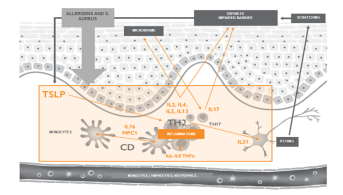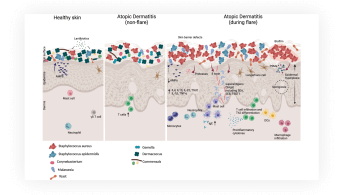Atopic Eczema
Atopic dermatitis (AD), a chronic inflammatory dermatosis, most often begins in infants as young as 3 months old and ceases in most cases by the age of 7, although it can persist into adulthood.
The mechanisms of AD are complex, combining immunological, genetic and environmental factors with skin hyperreactivity to allergens.
- Read more
-
AD combines skin dryness with inflammatory flare-ups that take the form of red plaques that ooze at first, then scab over. It progresses through alternating flare-ups and phases of remission.

To support your patients
Tips sheets
Co-prescription
To remember
suffers from atopic dermatitis*
suffers from atopic dermatitis*
from itching**
from dry skin**
from red plaques**
* S. Langan. A. lrwine. S Veidimger ; Atopic Dermatitis, The lancet Volume 396 (2020)
** Etude Arcane, Dermattte Atopique (2018)
Physical consequences
AD, chronic inflammatory dermatosis, involves a number of factors and major dysfunctions including a deterioration of the skin barrier and inflammatory reactions, maintained and exacerbated by skin dryness, pruritus and microbiome imbalance.
In babies and infants, red plaques are mainly located on the face (cheeks, under and behind the ears), neck and limbs. The torso can also be affected.
In children, red plaques appear mainly in the folds (neck, elbows, knees) and on the extremities (hands, wrists, ankles).
In adults, plaques persist most often on the face (eyelids, cheeks), torso and limbs, mainly localized in the folds (elbows, knees) and on the hands.

Psychological consequences
AD is experienced as a real burden by patients and their families.
The repercussions are significant, both for their health: stress, anxiety, loss of self-confidence... and in their daily lives (quality of life, social and professional life...).
The psychological impact is particularly linked to the symptoms and the difficulty of managing them, especially during flare-ups, which are more visible. The physical impact has psychological repercussions that compound the damage to self-esteem. that compounds the damage to self-esteem. In the background, acceptance of the disease, treatment-hopping, the constraint of treatments and fear of their side effects contribute to the malaise expressed by patients.

In the news

Summaries of publications and clinical results
Find all our summaries by expertise.
View all summariesWant to read on?
This access is reserved for professionals, registered on Pierre Fabre For Med.
To access the full content, please register or log in if you already have an account.






